Insects
Mt. Takao is considered one of the three major habitat of insects along with Minoo (Osaka prefecture) and Kibune (Kyoto prefecture) and it has long been loved by researchers of insects because of number of species and the easy access from the Metropolitan area. There are many insects first found in Mt. Takao and named after "Takao" such as Takao Shachihoko (Hiradonta takaonis Matsumura) and Takao medaka kamikiri (Stenhomalus takaosanus).
-
Tenodera angustipennis(Narrow-winged Mantis) Mantidae
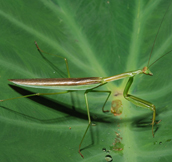
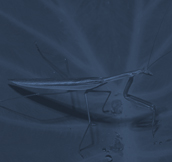 Tenodera angustipennis(Narrow-winged Mantis) Mantidae
Tenodera angustipennis(Narrow-winged Mantis) Mantidae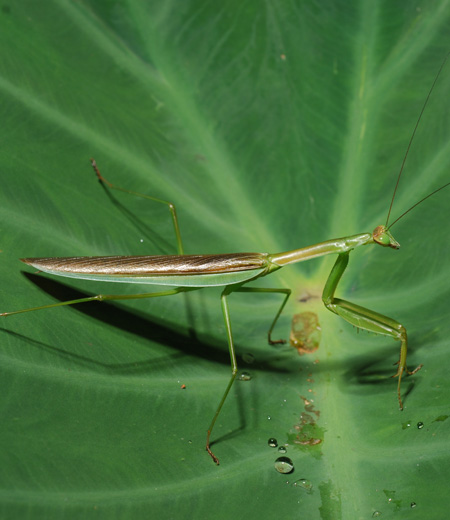 Main Region: Honshu, Shikoku, Kyushu and Nansei Islands. Found in grasslands from flatlands to mountains, riverbeds and parks in cities. Is most frequently found mantis and often called simply as mantis. Body color is either green or brown. grasping front legs are like sickles that are suitable for catching small insects that they are feed on. Rest on grass or trunks of trees and catch insects approached to them immediately with the fast front legs movement. Adults are also found near flowers in cirsium family. Have orange spots on the base of front legs. Similar Tenodera aridifolia have orange spots that are to distinguish this species. In autumn, female lays batches of eggs covered with sponge-like egg cases, called ootheca.
Main Region: Honshu, Shikoku, Kyushu and Nansei Islands. Found in grasslands from flatlands to mountains, riverbeds and parks in cities. Is most frequently found mantis and often called simply as mantis. Body color is either green or brown. grasping front legs are like sickles that are suitable for catching small insects that they are feed on. Rest on grass or trunks of trees and catch insects approached to them immediately with the fast front legs movement. Adults are also found near flowers in cirsium family. Have orange spots on the base of front legs. Similar Tenodera aridifolia have orange spots that are to distinguish this species. In autumn, female lays batches of eggs covered with sponge-like egg cases, called ootheca.
●Length about 65 to 90 mm
●Adults Flight Season August to about October -
Statilia maculata Mantidae
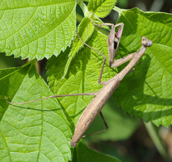
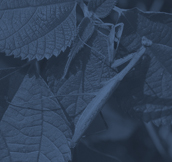 Statilia maculata Mantidae
Statilia maculata Mantidae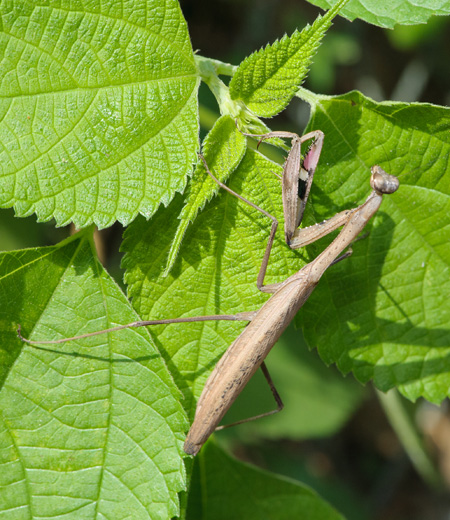 Main Region: Honshu, Shikoku, Kyushu, Izu Islands, Tsushima and Yaku Island. Found in forest and grasslands from flatland to mountains and farmlands. Body color is ocher to dark brown for most of species but green in rare cases. Inner sides of grasping front legs are black which is quite distinctive. When plants are green, found on ground or trees and in autumn found often on dead leaves. Ootheca is elongated and female lays them on rocks or tree trunks close to the ground.
Main Region: Honshu, Shikoku, Kyushu, Izu Islands, Tsushima and Yaku Island. Found in forest and grasslands from flatland to mountains and farmlands. Body color is ocher to dark brown for most of species but green in rare cases. Inner sides of grasping front legs are black which is quite distinctive. When plants are green, found on ground or trees and in autumn found often on dead leaves. Ootheca is elongated and female lays them on rocks or tree trunks close to the ground.
●Length about 36 to 60 mm
●Adults Flight Season August to about November -
Acromantis japonica Acromantidae
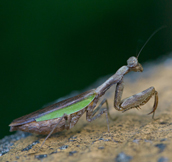
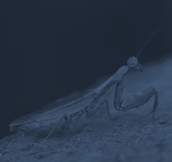 Acromantis japonica Acromantidae
Acromantis japonica Acromantidae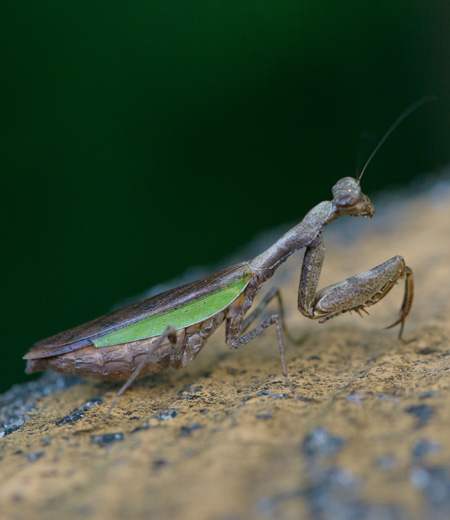 Main Region: Honshu, Shikoku, Kyushu and Nansei Islands. Found in woods and surrounding grasslands from low elevations to mountains. Is a very small mantis. Even the body size is around 3 cm, have big wings covering abdomen that is to identify adults. Body color is green and brown and some have mixed color for example brown on back and green on grasping front legs. When sensing dangers, stop moving and hold the body low, and drop itself to the ground. Sometimes place legs right beside abdomen pretending to be dead. Head is wide triangular-shaped with protruding compound eyes on either side. Nymphs emerged from eggs are black like ants.
Main Region: Honshu, Shikoku, Kyushu and Nansei Islands. Found in woods and surrounding grasslands from low elevations to mountains. Is a very small mantis. Even the body size is around 3 cm, have big wings covering abdomen that is to identify adults. Body color is green and brown and some have mixed color for example brown on back and green on grasping front legs. When sensing dangers, stop moving and hold the body low, and drop itself to the ground. Sometimes place legs right beside abdomen pretending to be dead. Head is wide triangular-shaped with protruding compound eyes on either side. Nymphs emerged from eggs are black like ants.
●Length about 25 to 32 mm
●Adults Flight Season June to about October -
Baculum irregulariterdentatum(Stick Insect) Phasmatidae
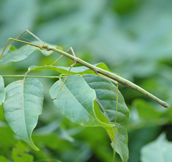
 Baculum irregulariterdentatum(Stick Insect) Phasmatidae
Baculum irregulariterdentatum(Stick Insect) Phasmatidae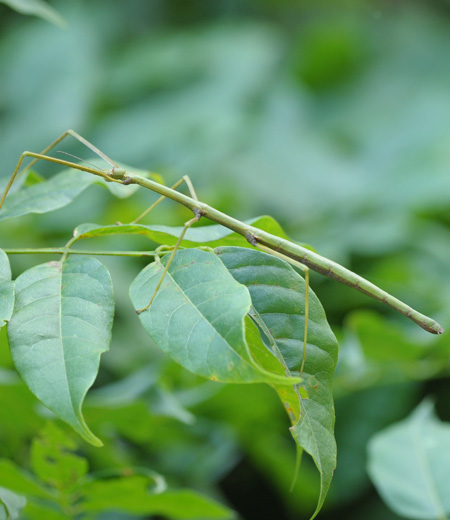 They live in main land Honsyu, Shikoku, Kyusyu.
They live in main land Honsyu, Shikoku, Kyusyu.
They inhabit at bushes and in green tracts of grassy places in low ground to low mountain areas.
Some of them have green body color, others have dark-brown.
As they are known very well, they transform themselves into the shapes such as branch of trees or stalk of leaves, and stay still so well that we cannot tell them.
Even imagines have no wings and don’t fly.
They move slowly from trees to leaves to eat leaves of pants including Flowering cherries and Quercus serrate.
Very similar Phraortes illepidus has antennas as long as their front legs, by which we can tell them from the others.
Furthermore, there live Micadina phluctaenoides having wings at Mt. Takao, which have a very rare reproduction style ‘Parthenogenesis’ that means females can lay eggs without copulation with males.
●Length about 60 to 100 mm
●Adult Flight Season July to about November -
Bombylius majo Bombyliidae
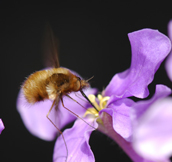
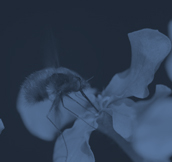 Bombylius majo Bombyliidae
Bombylius majo Bombyliidae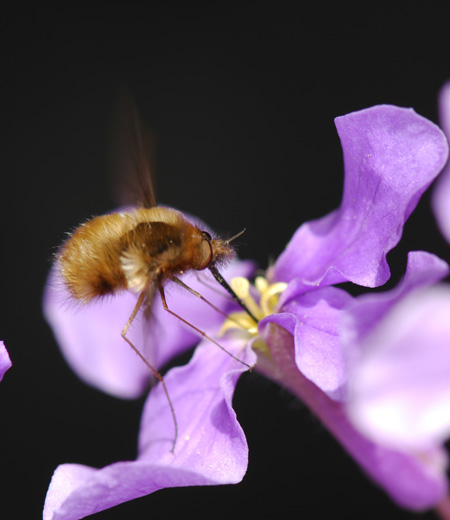 Main Region: Hokkaido, Honshu, Shikoku, Kyushu and Okinawa.
Main Region: Hokkaido, Honshu, Shikoku, Kyushu and Okinawa.
Found in woods and grasslands from flatlands to low elevations and also in sunny parks with lots of plants.
Almost entire body from head, thorax to abdomen is covered with velvet-like yellow-brown hair and adults are only seen for a short time during spring.
Have straw-like elongated mouthparts and suck nectar of flowers.
Hover while flying which looks like it is hanging in the air, hence the Japanese name velude-tsuriabu (bombyliidae) literally velvet hanging horse-fly.
Larvae feed on larvae in andrenidae family.
●Length about 8 to 12 mm
●Adults Flight Season March to about May -
Chrysoperla nipponensis Chrysopidae

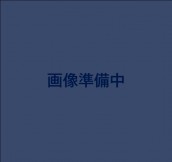 Chrysoperla nipponensis Chrysopidae
Chrysoperla nipponensis Chrysopidae They live widely in Hokkaido, main land Honsyu, Shikoku, Kyusyu, and Okinawa Island as well as Yakushima Island and Tanegashima Island.
They live widely in Hokkaido, main land Honsyu, Shikoku, Kyusyu, and Okinawa Island as well as Yakushima Island and Tanegashima Island.
They inhabit at plain field and grassy places in plain ground and low mountain areas.
They belong to the group of Chrysopa intima.
The body color is pale green and the wings are transparent with its wing veins in green.
One yellow line on their back helps us to distinguish them with others.
The eyes are tinged red, which are lustrous like metals.
They can be seen from early spring to autumn.
They have been carnivorous all through since larvae to imagines, so that they stay still on the leaves of the plants so as to catch and eat insects.
They love Aphidoidea so much that human often make use of Aphidoidea for extermination.
Their eggs are laid on the leaves or fruit, but the eggs are attached on the top of about 5 millimeters’ slender filaments called ‘ Udonge‘ (the eggs of the lacewing).
Occasionally, they are attracted to go to the light within human residence, and they lay eggs on the lighting equipment.
●Length about 10 mm
●Adult Flight Season April to about November -
Hagenomyia micans Myrmeleontidae
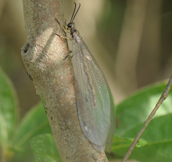
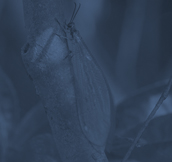 Hagenomyia micans Myrmeleontidae
Hagenomyia micans Myrmeleontidae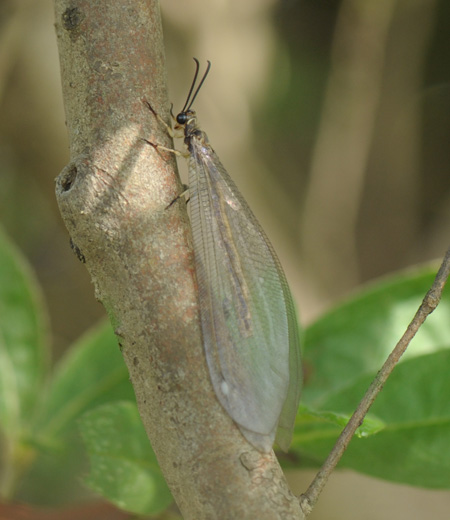 Main Region: Hokkaido, Honshu, Shikoku, Kyushu and Nansei Islands. Found in forest edges and grasslands from flatlands to mountains. Have four transparent wings and body shape is similar to dragonfly but the way this species fly is rather flattering and too delicate. Have fine net-like appearance wing veins and with white spots towards tips of fore wings. Larvae are also called as ant lion, Ari-jigoku in Japanese literally meaning hell for ants. Digs a pit on sandy ground where is no risks of rain. Place a food for ants at the bottom of a pit and wait for ants to get trapped. In Mt. Takao, found these pits on slopes covered by trees and under benches in mountain trails. Larvae create small cocoons to become pupa in sand and emerge to adults in summer.
Main Region: Hokkaido, Honshu, Shikoku, Kyushu and Nansei Islands. Found in forest edges and grasslands from flatlands to mountains. Have four transparent wings and body shape is similar to dragonfly but the way this species fly is rather flattering and too delicate. Have fine net-like appearance wing veins and with white spots towards tips of fore wings. Larvae are also called as ant lion, Ari-jigoku in Japanese literally meaning hell for ants. Digs a pit on sandy ground where is no risks of rain. Place a food for ants at the bottom of a pit and wait for ants to get trapped. In Mt. Takao, found these pits on slopes covered by trees and under benches in mountain trails. Larvae create small cocoons to become pupa in sand and emerge to adults in summer.
●Length about 34 to 38 mm
●Adults Flight Season August to about September -
Protohermes grandis(Dobsonfly) Corydalidae
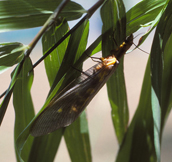
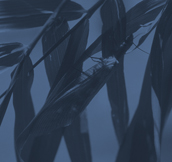 Protohermes grandis(Dobsonfly) Corydalidae
Protohermes grandis(Dobsonfly) Corydalidae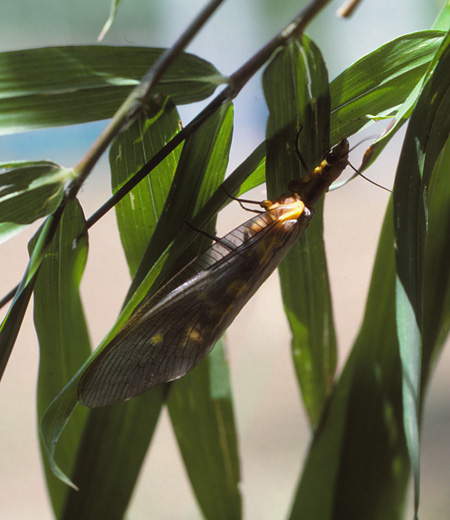 Main Region: Hokkaido, Honshu, Shikoku and Kyushu.
Main Region: Hokkaido, Honshu, Shikoku and Kyushu.
Found in mountain streams and forests from flatlands to mountains.
Have skinny body with large four wings but they are not in family of dragonflies.
The major difference from dragonflies is holometabolism which includes pupa stage where as dragonflies are hemimetabolic. Body color is light yellow-brown with yellow spots on wings.
Rest in forests and grasslands near streams during daytime and become active at night and fly to various trees for sap.
Also are attracted to lights.
Have large mandibles on head and try to bite by moving long thorax parts when randomly caught by human beings. This resembles snakes, hence the Japanese name hebi-tombo literally meaning snake dragonfly.
Larvae are called magotaro-mushi literally meaning grandson bugs and live in clear water and eat aquatic insects.
●Length about 36 to 40 mm
●Adults Flight Season June to about September -
Parachauliodes japonicus Corydalidae
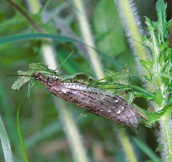
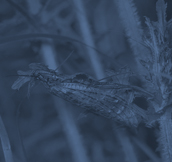 Parachauliodes japonicus Corydalidae
Parachauliodes japonicus Corydalidae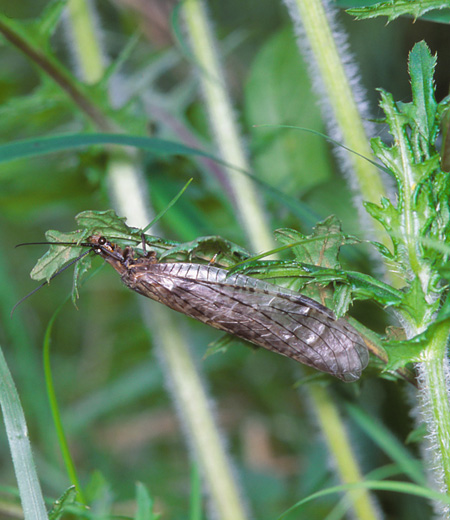 Main Region: Honshu, Shikoku, Kyushu and Nansei Islands.
Main Region: Honshu, Shikoku, Kyushu and Nansei Islands.
Found in woods near rivers and grasslands along streams from flatlands to mountains.
Body color is light brown with distinct wing veins.
Fly in forests or over streams and feed on sap of sawtooth oak and juice of fruits.
Larvae live in slow-flowing upstream and feed on nymphs of ephemeroptera.
Often used as feeds for mountain stream fishing.
The final stage of larvae lives on ground and become pupa in soils near streams.
●Length about 45 to 55 mm
●Adults Flight Season May to about July -
Panorpa japonica Panorpidae
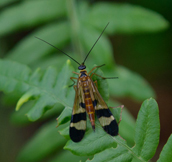
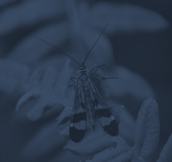 Panorpa japonica Panorpidae
Panorpa japonica Panorpidae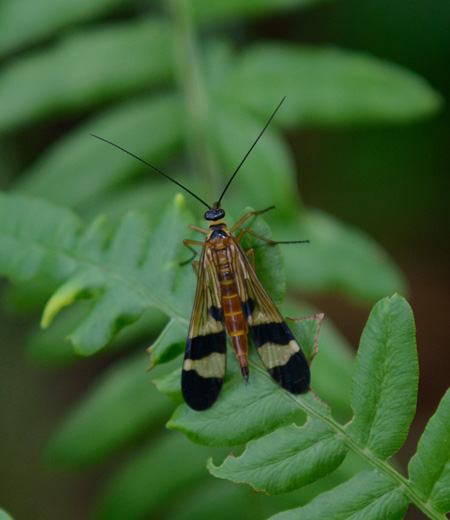 Main Region: Honshu, Shikoku and Kyushu.
Main Region: Honshu, Shikoku and Kyushu.
Found in woods and green space from low elevations to mountains.
From the middle of abdomen to the tip of abdomen is curled like tails of scorpions as panorpidae in Japanese means curled tip of abdomen states.
This is unique to male and the abdomen of female is thick and does not curl at tips.
Tips of abdomen of male are scissors-like shape that is used to hold female when mating and to fight with other males.
Feed on body fluids of dead insects and juice of fruits.
Male feed female dead insects and mate while female is eating that is unique to this species.
Ones emerge in spring are black body color but the ones in summer have yellowish and does look like other species.
Larvae live in soils and become pupa by making cocoons.
●Length about 13 to 20 mm
●Adults Flight Season April to about September -
Ephemera japonica Ephemeridae
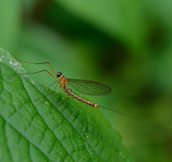
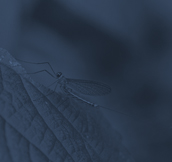 Ephemera japonica Ephemeridae
Ephemera japonica Ephemeridae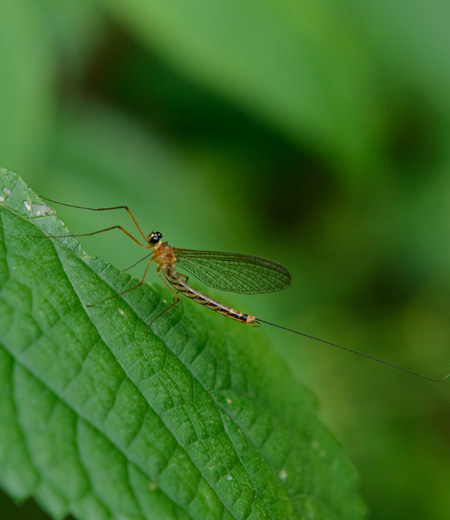 They live in Hokkaido, main land Honsyu, Shikoku, Kyusyu.
They live in Hokkaido, main land Honsyu, Shikoku, Kyusyu.
They inhabit at the river basin in low mountain area and mountains, and at the grassy places in the area.
The body is brown color and they have lots of black diagonal lines (lines downward to the right when you see their head in the left) at the abdomen.
This line is the good point to distinguish Ephemera japonica from Mayfly.
Their tail is about twice as long as the body length and the wing veins are black in the transparent wing, which they use to fly slowly over river surface.
Their larvae live a life in the clear water of rives.
As imagines have degenerated mouth, they don’t eat bait.
Instead, they utilize all the nourishment that they have stored as much as they can; they use to act for breeding.
While breeding, lots of them are fallen into the river, consequently they also become the bait for birds and fishes. Flying fishers use many Mayfly-shaped lures as fake-bait
●Length about 10 mm
●Adult Flight Season June to about October -
Pedetontus nipponicus Machilidae
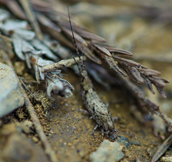
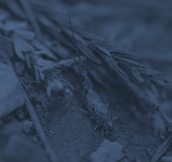 Pedetontus nipponicus Machilidae
Pedetontus nipponicus Machilidae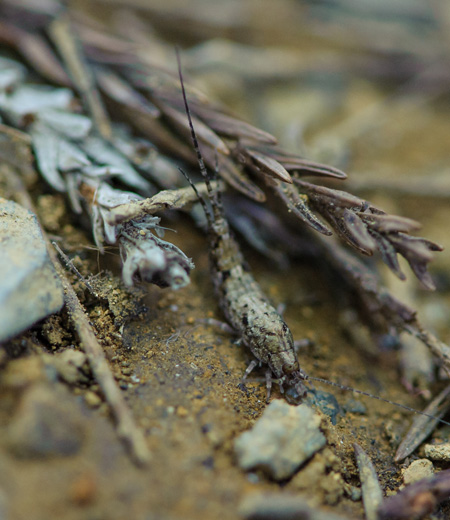 They live in Hokkaido and main land Honsyu.
They live in Hokkaido and main land Honsyu.
They inhabit at underneath of stones, fallen trees, and shedding leaves at rather humid copses in low ground to mountain areas.
Group of Machilidae is characterized as no wings, and the structure of their chin still remains ancient type.
Therefore, they are sometimes called ‘living fossils’.
Their characteristics are the long antennas and the lobster-shaped figure with three tails, of which the center tail is extremely long, and the body color is protective coloration.
There is difference rarely seen in appearances between larvae and imagines. Even imagines have a habit of shedding.
Their main bait includes seaweed on and in the soil.
Though one part of their name means ‘Flea’ due to their flying, they don’t suck blood unlike Flea.
This insect is not so known in the public, but here, at Mt. Takao we can see them almost all areas at the fallen leaves gathering places.
●Length about 10 mm
●Adult Flight Season April to about November
